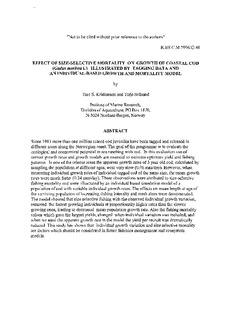Effect of size-selective mortality on growth of coastal cod (Gadus morhua L.) illustrated by tagging data and an individual-based growth and mortality model
Working paper
Permanent lenke
http://hdl.handle.net/11250/105580Utgivelsesdato
1996Metadata
Vis full innførselSamlinger
Originalversjon
This report is not to be cited without prior reference to the authorsSammendrag
Since 1983 more than one million reared cod juveniles have been tagged and released in
different areas along the Norwegian coast. The goal of the programme is to evaluate the
ecological and economical potential in sea ranching with cod. In this evaluation use of
correct growth rates and growth models are essential to estimate optimum yield and fishing
pattems. In one of the release areas the apparent growth rates of 3 year old cod, calculated by
sampling the population at different ages, were very slow (0.08 mm/day). However, when
measuring individual growth rates of individual tagged cod of the same size, the mean growth
rates were much faster (0.24 mm/day). These observations were attributed to size-selective
fishing mortality and were illustrated by an individual based simulation model of a
population of cod with variable individual growth rates. The effects on mean length at age of
the surviving population of increasing fishing intensity and mesh sizes were demonstrated.
The model showed that size selective fishing with the observed individual growth variation,
removed the fastest growing individuals at proportionally higher rates than the slower
growing ones, leading to decreased mean population growth rate. Also the fishing mortality
values which gave the largest yields, changed when individual variation was included, and
when we used the apparent growth rate in the model the yield per recruit was dramatically
reduced. This study has shown that individual growth variation and size selective mortality
are factors which should be considered in future fisheries management and ecosystem
models.
